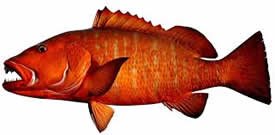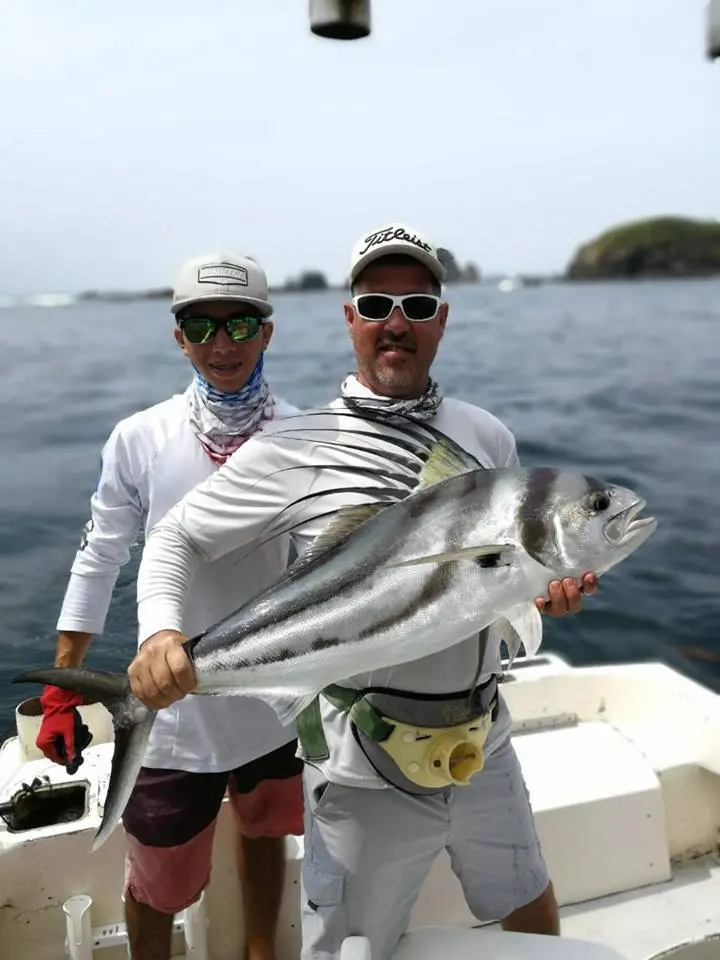The coasts of Costa Rica have different types of fish available to fish throughout the year in the North Pacific Papagayo.

Cubera Snapper – Pargo Colmillon
The Cubera snapper is a territorial fish in the Gulf of Papagayo, and grows around 200 pounds or more, its habitat is in shallow and deep waters of 300 feet, Also, it is opportune to catch it when we are fishing Roosterfis in small sizes. It is a good eating fish when 10 pounds, catch and release is strongly recommended for more than 80 pounds for the all fishermen when fishing in Gulf Papagayo and preserve the species.

Mahi-mahi – Dorado
Fishing mahi-mahi is through the year in the Gulf of Papagayo, they mate and spawn on winter seasons in the months of March and thrive in just 6 months, reach the height of up to 4 feet, weight approximately 40 pounds, their rapid growth is due to the abundance of food dragged by the oceanic currents which cross the Gulf of Papagayo from south to north.
They like the warm, clean water; their favorite food is Ballyhoo and Skipjack.

Roosterfish – Pez Gallo
Roosterfish Fishing in the Gulf of Papagayo.
They can be found year-round in the Gulf of Papagayo, particularly in shallow coastal waters. The province of Guanacaste has an extensive Pacific shoreline, offering excellent fishing conditions, especially in warm and slightly turbid waters.
Their favorite prey is black tuna (Bonita). Rooster fish are highly prized in Costa Rica for their strong fighting ability, making them a popular target among sport fishermen. However, they are not considered good for eating. Therefore, catch and release practices are strongly recommended to help preserve the species.
Rooster fish can reach impressive sizes, often exceeding 4 feet in length and, on rare occasions, weighing more than 110 pounds.
This species is abundant in the Gulf of Papagayo, located in the North Pacific region of Costa Rica.

Pez Marlin
Fishing season for Marlin in the Gulf of Papagayo runs year-round, with an abundant presence of this species, usually found in the same areas as sailfish. Due to its size and characteristic dorsal fin, the marlin is a large and heavy fish, known for putting up an intense fight of up to four hours once hooked. Its favorite food includes baits such as ballyhoo and bonito, and it is a typical species of deep ocean waters. Marlin can reach a maximum weight of approximately 1,300 pounds and prefers to swim in clear, deep waters. During the winter months, it usually approaches flatter waters up to 30 feet deep, where temperature and clarity conditions are optimal. During this time, it seeks out small dorados, which are abundant in the gulf, making fishing in Papagayo an especially active and exciting experience.

Sailfish – Pez Vela
The Sailfish is a species of large size, weight reaches up to 300 pounds at most. It is a species that gives a great fight when is caught, you can also try fly fishing. Its favorite food is the ballyhoo and small bonitos baitfish. They enter to the Gulf of Papagayo for fishing baitfish on flat water in search of food at 50 feet with optimal conditions of temperature and clarity, They move to shallow waters for a period of time, and it is a time to locate them and start fishing for sailfish in the Gulf of Papagayo.

The Yellowfin Tuna
The Yellowfin tuna years ago, was overexploited species in our country by international companies. We, in the all country and also in the Gulf of Papagayo suffer that negative situation when we did fishing, but, now these species are growing up since government of Costa Rica implement new laws to protect the fishing for yellowfin tuna, they move with the currents of the sea and travels through the continents, they seek shallow waters for their reproduction and when they reach maturity, they deepen.
Specimens of up to 400 pounds are caught in deep water; in the Gulf of Papagayo you can get up to 70 pounds in the shallow waters.

Red Snapper
In the Gulf of Papagayo, fishing locations abound as rocky bottom which is attractive places for the red snapper.
Species desired by the artisanal fishermen who make their daily and monthly budget, and in its preference are those from 2 to 5 pounds of weight that is first quality. Also, with regard to sport fishing, it is practiced as bottom fishing and is a great attraction but there are always good-sized ones like 12 pounds in some months but they are mostly small due to their over-exploitation.
The Red Snapper with bigger size is in the months of March and April (Summer); this activity is accelerated with the arrival of the oily sardine, of good taste for snapper in the Gulf of Papagayo and the entire Pacific coast of Costa Rica.

Skipjack – Bonita – barrilete
Bonito (Black Tuna)
This type of fish, commonly known as bonito, belongs to the tuna family. Bonita (Skypjack) is abundant throughout the year in Guanacaste fishing on the surface, making it a popular target for sport fishing with light tackle. Bonitos usually feed on small sardines and are also known as black tuna.
They are often used as special bait for many other species, including sailfish and rooster fish, either as live bait or as “butterfly bait” when dead.
Fishing for bonito on the surface with light tackle is another exciting way to enjoy sportfishing in Guanacaste, as they put up an impressive fight. Their average weight rarely exceeds 10 pounds.

Hamberjack – Ojaran
Amberjack is a territorial fish commonly found when fishing in Guanacaste. This species can grow up to about 200 pounds and usually lives around rocky bottoms, feeding on small fish. When fishing for the roosters, there’s also a good chance to catch amberjack, since both species respond to the same type of bait. Amberjack has excellent meat — even juveniles are considered very good to eat.

Grouper – Cabrilla
Its habitat is the deep ocean, ranging from 100 to 500 feet in depth. The meat is highly valued for its excellent flavor. During colder periods in the depths, this species moves toward the shores of the Gulf of Papagayo in search of warmer waters.
Bottom fishing for grouper in the Gulf of Papagayo is best during the summer months, from January to March. These fish can weigh up to 150 pounds and feed on small fish, crustaceans, squid, and other bottom-dwelling marine fish.

See Bass – Robalo
The snook is a territorial fish commonly found at river mouths and along beaches. It has white, delicious meat and typically weighs around 12 kilograms. As a predator, its diet mainly consists of crustaceans, worms, small fish, sea urchins, and other marine creatures. The best way to fish for snook in Papagayo is either from the shore or from a boat using light fishing gear.🐟

Wahoo
This species in the Gulf of Papagayo is considered a winter-season fish, as the best water and temperature conditions occur during those months. In June and July, they are often found in pairs and are most frequently sighted along the Pacific coast. They also inhabit deeper waters. Their size and weight can reach up to 5 feet and around 60 pounds, and they can swim at speeds of up to 40 miles per hour. Their favorite prey consists mainly of small fish.
At Papagayo Fishing, we catch Wahoo using Rapala lures and wire leaders. Often, when we are Roosterfish fishing, Wahoo chases our bait and cut our fishing lines.
